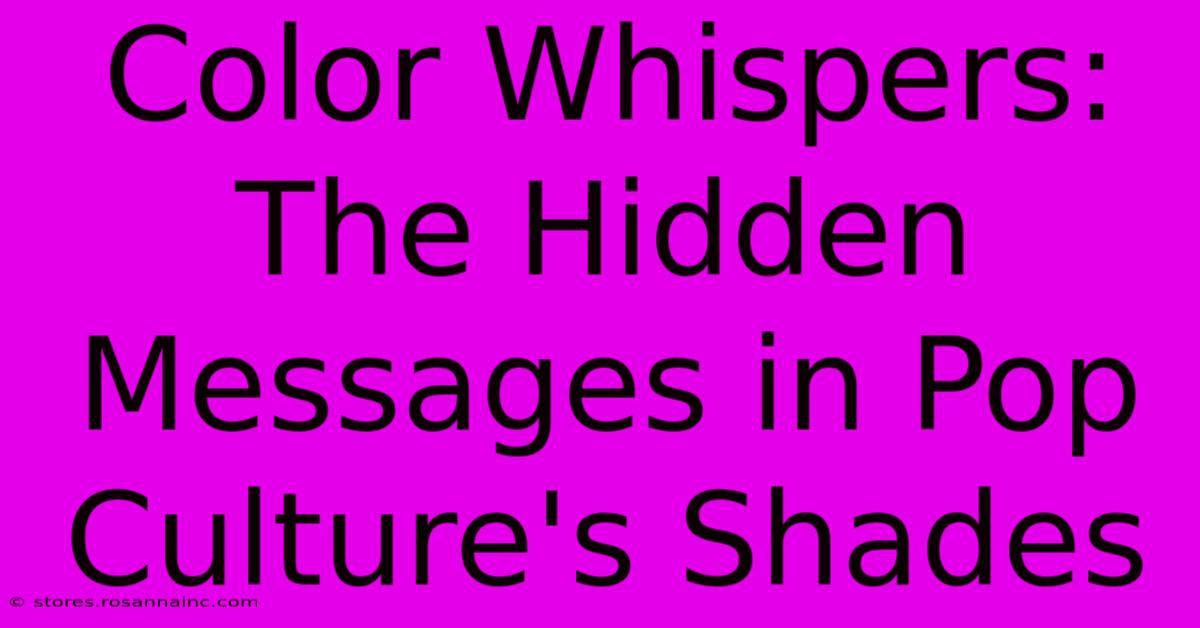Color Whispers: The Hidden Messages In Pop Culture's Shades

Table of Contents
Color Whispers: The Hidden Messages in Pop Culture's Shades
Color. It's more than just a pretty picture; it's a powerful communicator, weaving its way into the very fabric of pop culture. From the vibrant hues of superhero costumes to the subtle shades in movie scenes, color choices are rarely accidental. They whisper hidden messages, influencing our emotions and shaping our understanding of characters and narratives. This exploration delves into the psychology of color and how it's masterfully used to amplify meaning in film, television, music, and beyond.
The Psychology of Hues: What Colors Convey
Before diving into pop culture examples, let's establish a foundational understanding of color psychology. Different colors evoke distinct emotional responses:
- Red: Often associated with passion, energy, danger, and excitement. Think of the fiery red capes of superheroes or the intense red lighting used in horror films to heighten suspense.
- Blue: Frequently symbolizes tranquility, trust, calmness, and sometimes sadness or melancholy. Consider the calming blue hues often used in corporate branding to project reliability or the somber blues used to depict loneliness in films.
- Green: Represents nature, growth, harmony, and often envy or jealousy, depending on the context. Think of the lush green landscapes in fantasy films representing untamed beauty or the sickly green of a villain's lair hinting at toxicity.
- Yellow: Evokes feelings of happiness, optimism, warmth, but can also signify caution or deceit. Think of the cheerful yellow of children's cartoons contrasted with the ominous yellow of a warning sign.
- Purple: Often associated with royalty, luxury, mystery, and spirituality. Its use in fantasy films and high-end branding reinforces these associations.
- Black: Represents power, sophistication, mystery, and often death or evil. The use of black in villain costumes or dramatic scenes underscores these meanings.
- White: Symbolizes purity, innocence, peace, and sometimes sterility or emptiness. Consider the white attire of angels in religious art or the stark white walls of a sterile hospital room.
Color in Film and Television: A Visual Language
Film and television are masters of using color to set the tone, develop characters, and advance the narrative. Consider these examples:
The Matrix (1999): The iconic green-tinted world of the Matrix uses color to distinguish reality from the simulated world.
The Wizard of Oz (1939): The stark contrast between the sepia-toned Kansas and the vibrant color of Oz significantly contributes to the story's magical realism.
Sin City (2005): The film's use of mostly black and white with splashes of intense color strategically highlights key elements and adds to its noir atmosphere.
Color in Music and Branding: Beyond the Screen
Color's influence extends beyond the visual medium. Music videos, album art, and branding strategies all leverage the power of color to communicate specific messages:
Album Art: Think about iconic album covers. The dark and brooding colors of many metal albums reflect the genre’s intensity, while brighter, more playful colors often characterize pop music.
Branding: Companies carefully select colors that reflect their brand identity. Think of the instantly recognizable red of Coca-Cola or the calming blue of IBM.
Decoding the Color Code: A Deeper Dive
The power of color in pop culture lies in its subtlety and its ability to tap into our unconscious biases. Recognizing and understanding these color cues deepens our appreciation and understanding of the art we consume. Next time you watch a film or listen to an album, pay close attention to the color palette. What message is the artist or filmmaker trying to convey?
Conclusion:
Color is a silent storyteller, weaving its narrative through the threads of our cultural landscape. By understanding the psychology of color and its masterful use in various media, we unlock a deeper appreciation for the richness and complexity of pop culture. The next time you encounter a striking color choice, pause and consider its hidden message – you might be surprised by the depth of meaning it reveals.

Thank you for visiting our website wich cover about Color Whispers: The Hidden Messages In Pop Culture's Shades. We hope the information provided has been useful to you. Feel free to contact us if you have any questions or need further assistance. See you next time and dont miss to bookmark.
Featured Posts
-
Unlock Your Writing Potential Convert Passives To Actives With Ease
Feb 04, 2025
-
Lens Of The Gods Viltrox Fe 20mm F2 8 Unleashes The Hidden Potential Of Sony Sensors
Feb 04, 2025
-
Mea Culpa Uncover The Secrets Behind Our Apologetic Slip Ups
Feb 04, 2025
-
Transform Your Living Room The Blanket That Elevates Your Sunday Style
Feb 04, 2025
-
Unleash Your Brands Sparkle Business Cards With Shimmering Charm
Feb 04, 2025
